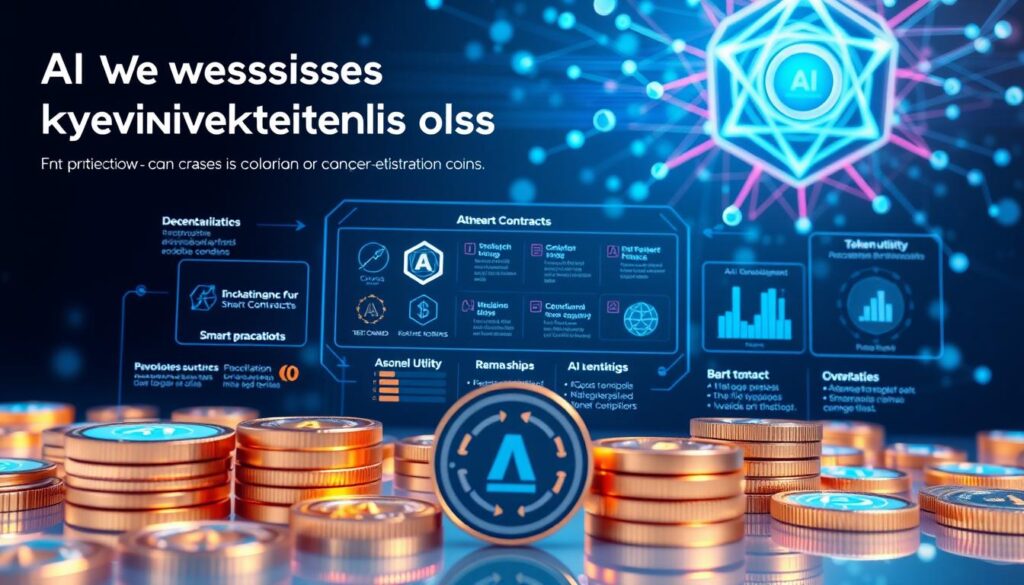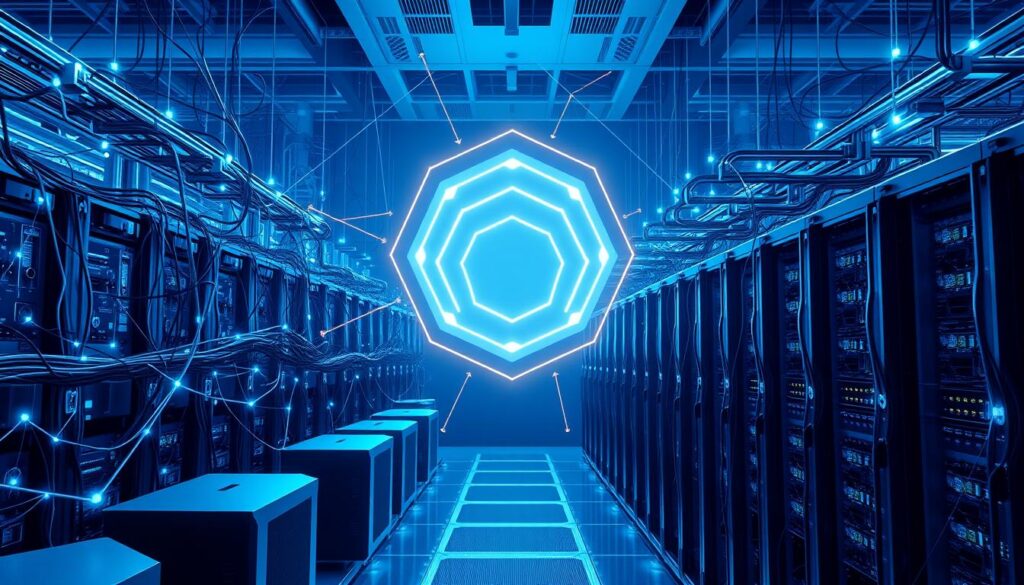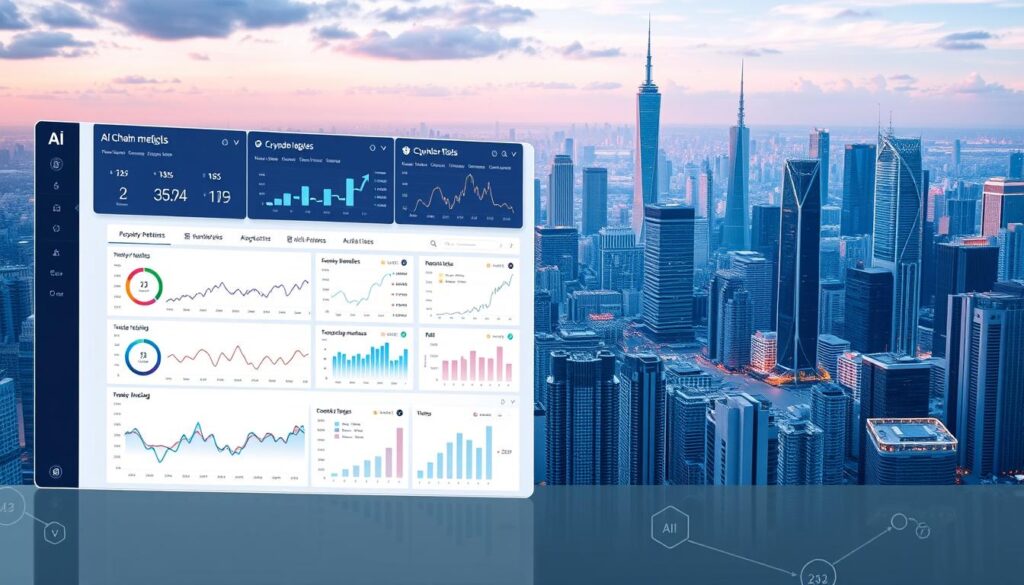Now Reading: Top Best AI Cryptocurrency Coins to Invest in 2026
- 01
Top Best AI Cryptocurrency Coins to Invest in 2026
Top Best AI Cryptocurrency Coins to Invest in 2026

This product roundup guides U.S. investors through the leading AI-focused crypto opportunities heading into 2026. By mid-2025, dedicated tokens reached an estimated $24–27 billion market cap after a volatile cycle of rallies and consolidation.
We compare major names like Bittensor (TAO), Fetch.ai (FET), Render (RNDR), Internet Computer (ICP), The Graph (GRT), SingularityNET (AGIX), Ocean Protocol (OCEAN), Akash (AKT), NEAR, and Virtuals. The focus is on real-world utility, active communities, and robust ecosystems rather than hype.
Readers will get clear evaluation criteria: technology, token utility, developer momentum, governance, and traction, paired with liquidity and U.S. custody practicality. Expect an objective, research-driven view of growth and risks across large-cap leaders and earlier-stage projects.
What follows: a macro thesis, selection methodology, leaders to watch, detailed profiles, contenders, risk design, and trends that matter beyond 2026.
Key Takeaways
- Mid-2025 saw a multi-billion market cap for the niche, but volatility remains high.
- Focus on utility, developer activity, and governance over short-term moves.
- We assess tokens by tech, traction, listings, and custodial access in the U.S.
- Coverage includes both established leaders and higher-risk early projects.
- Actionable insights help build watchlists and compare liquidity and exchange access.
Why AI + Blockchain Is Poised to Lead Crypto in 2026
The blend of machine intelligence and distributed ledgers is creating measurable utility for users and builders.
Automation and transparency together speed real-world adoption. Machine models enable faster decisions, predictive analytics, and smart optimizations. Immutable ledgers supply high-integrity data that makes those models more reliable and auditable.
Real-world applications driving adoption: trading, DeFi, data, and DAOs
Practical use cases are visible now: automated trading bots, DeFi rate optimization, fraud detection, and NFT pricing that uses on-chain signals.
AI supports liquidity management, lending optimization, and governance tooling where proposals and treasury moves are informed by models while humans retain final control.
Synergy: transparent ledgers meet intelligent, autonomous agents
- Agents can coordinate payments, data exchange, and service discovery across interoperable networks.
- Data-rich chains feed machine learning pipelines, improving model fidelity and audit trails for users.
- End-to-end systems pair decentralized compute and storage with inference for production-grade services.
Bottom line: networks and projects that embed intelligence into native workflows will gain measurable traction across the market for crypto services.
Best AI cryptocurrency coins to invest in 2026: expert roundup and how we chose
We used a clear, repeatable framework to compare tokenized projects that show production use and durable developer momentum.
Selection framework: utility in production, developer activity, community engagement, and credible go‑to‑market. Each candidate was scored on real usage, code commits, and partnership traction.
What U.S. investors compare before buying
Token-level checks include emission schedules, staking and governance rights, fee mechanics, and net demand sustainability.
- Trading and access: order-book health, liquidity, and listings on regulated U.S.-friendly venues.
- Performance lens: multi-cycle resilience over single-cycle spikes; preference for projects shipping core capabilities.
- Governance and research: documentation quality, upgrade cadence, on-chain activity, repo commits, and institutional participation.
| Factor | Infra networks | App-layer networks |
|---|---|---|
| Priority | Compute, data integrity | Agent adoption, UX |
| Token role | Payments, node rewards | Service fees, governance |
| Risk screen | Audits, treasury disclosures | Oracle dependence, central points |
Bottom line: the leaders list that follows uses these consistent criteria to help investors weigh market access, support, and long-term viability.
AI crypto market outlook: from 2025’s $24-27B cap to a bigger 2026
By mid‑2025 the market cap for AI tokens narrowed to roughly $24–27B following sharp swings in 2024. That consolidation pruned weaker narratives and left projects with tangible utility and developer momentum.
Volatility and consolidation after 2024–2025 rallies
Volatility remained a constant theme: sharp rotations and liquidity shifts drove frequent re‑pricings. Periodic rallies still rewarded leaders, but sector‑wide pullbacks normalized valuations.
Growth catalysts: decentralized compute, datasets, and agent networks
Several supply‑side and demand signals could expand the market in the next cycle. Decentralized compute and GPU markets address capacity needs for model training and inference.
Improved datasets, privacy‑preserving access, and cross‑chain interoperability will boost usable data and marketplace activity. Tokens tied to core infrastructure — training, inference, and data access — tend to track real demand from builders and enterprises.
Transparent metrics like active subnets, job throughput, and dataset transactions will be watched closely. Still, plan for multiple scenarios: bull, base, and bear — and expect token utility to grow as agent networks convert real workflows into on‑chain service calls.
How to evaluate AI crypto coins: technology, token utility, and ecosystem signals
A disciplined checklist helps separate durable projects from hype. Start by reading whitepapers and technical docs, then map protocol features against real-world use cases.

Use cases and model: data marketplaces, GPU rendering, autonomous agents
Match each protocol’s architecture to clear use cases like dataset exchange, decentralized rendering, or agent orchestration.
Look for live flows: dataset transactions, job throughput, and node participation rather than only roadmap promises.
Team, governance, and community activity as leading indicators
Evaluate the founding team, repo commits, audits, and partnership announcements. Those reveal delivery capacity.
Check governance: proposal clarity, voter turnout, and upgrade paths that balance safety and evolution. Track community channels and developer grants as traction signals.
Liquidity, listings, fees, and multi-chain support that matter in trading
Verify exchange depth, spreads, and custody support. Measure on-chain fees and bridge fees that affect net returns.
Multi-chain availability can broaden reach but adds security trade-offs. Use research metrics and a comparative scorecard to weigh fundamentals versus momentum before sizing positions.
Leaders to watch in 2026: TAO, FET/ASI, RNDR, OCEAN, ICP, and AGIX
This snapshot compares core leaders by market metrics, network design, developer activity, and governance maturity.
Side-by-side view: Bittensor (TAO) ran 118–120+ subnets with a roughly $2.9–3.0B market cap and a proof-of-intelligence consensus that attracts active validators and developers.
Fetch.ai’s FET moved toward ASI alignment for agent-centric services and cross-chain bridges across Ethereum, Cosmos, and Cardano. Render (RNDR) supplies GPU marketplaces with clear job throughput and creator payments.
Ocean focuses on data monetization and compute-to-data flows with enterprise partnerships. ICP offers on-chain hosting and low-fee execution that appeals to app builders. AGIX supports a marketplace for AI services with staking and governance tied into ASI coordination.
| Project | Cap scale | Network | Governance & staking |
|---|---|---|---|
| TAO | ~$3B | Multi‑subnet, PoI | Active validators, rewards |
| FET/ASI | Mid‑cap | Agent/interop | Proposal alignment, staking |
| RNDR/OCEAN/ICP/AGIX | Varied | Compute, data, hosting, services | Voter participation varies |
- Compare staking models and voter turnout when sizing positions.
- Watch developer signals: subnets, repo commits, grants, and integrations.
- Performance context: stronger fundamentals often rebound faster in a cyclical market, but volatility remains high.
Bittensor (TAO): decentralized AI training and incentives
Bittensor operates as a high‑activity network that rewards contributors based on output quality. The protocol pairs measurable contributor scoring with wide exchange access and frequent market moves.

Market cap and performance. TAO traded near $322 with a roughly $2.9–3.0B market cap in mid‑2025 after an ATH around $760 in April 2024. Price volatility has been notable, with periods of strong outperformance and weekly rallies that attracted retail and institutional flows.
Network and model
The protocol uses a proof‑of‑intelligence consensus. Peers evaluate model outputs and rank contributors. That peer scoring directs token rewards toward higher‑quality work.
The ecosystem hosts 118–120+ specialized subnets. This breadth signals task diversification across language models, vision, and other domain‑specific agents.
Token utility and governance
TAO’s token supports staking, participation, and governance. Staking aligns incentives for validators and model maintainers, while governance votes shape upgrades and grant allocations.
Developer and validator activity is a core health metric. Subnet launches, upgrades, and open‑source commits show ongoing engagement. Liquidity and broad listings improve trading access for U.S. participants.
| Metric | Value | Note |
|---|---|---|
| cap | ~$2.9–3.0B | Mid‑2025 |
| subnets | 118–120+ | Specialized models |
| staking | Active | Rewards & governance |
Risks include dependence on honest evaluation, collusion vectors, and the need for continued protocol hardening. Watch roadmap items: scaling subnets, evaluation robustness, and cross‑network integrations.
Bottom line: TAO sits among leading decentralized infrastructure plays with clear network activity and evolving governance that link token incentives to real demand for decentralized training and inference markets in crypto.
Fetch.ai (FET) and the Artificial Superintelligence Alliance (ASI)
Fetch.ai enables small autonomous agents that automate market tasks, mobility bookings, and data workflows for enterprises and builders.
Agent model: agents discover services, negotiate payments, and execute actions across platforms. This model reduces manual overhead for routine tasks and opens programmable service markets.
ASI merger and cross‑chain scale
The ASI alliance aims to link Fetch, SingularityNET, and Ocean for broader interoperability across Ethereum, Cosmos, and Cardano. That union seeks shared tooling, pooled liquidity, and unified developer support.
Signals investors watch
- Enterprise pilots and DeFi agent integrations that show real usage.
- Order‑book depth, listings, and custody support easing U.S. on‑ramps.
- SDK adoption and cross‑chain bridges that let agents act across any chain.
| Signal | Why it matters | FET/ASI note |
|---|---|---|
| Agent deployments | Shows product‑market fit | Enterprise pilots reported |
| Liquidity | Supports trading and price stability | Pooled exchange listings planned |
| Governance | Aligns tokenholders on upgrades | Cross‑ecosystem proposals required |
Bottom line: FET/ASI’s path depends on agent usage growth, enterprise integrations, and durable liquidity. Execution risks include merger complexity and secure bridging across chains.
Render Network (RNDR): GPU compute for AI, AR/VR, and 3D creators
Render Network turns idle GPUs into a global marketplace for creators and developers. RNDR powers decentralized GPU rendering for graphics and ML workloads, matching demand with spare capacity from node operators.

Real-world applications and workflows
Real-world applications include generative model training, on‑demand inference, large-scale 3D rendering, and AR/VR pipeline processing. Elastic GPU supply helps creators scale batch renders and model inference without long cloud procurement cycles.
Transparent job pricing and queueing let users estimate completion time and fees. This model benefits studios, freelance artists, and ML teams that need burst capacity for peak workloads.
Token design, fees, and network mechanics
The RNDR token facilitates job payments, compensates node operators, and grants governance rights. Fees are paid per job and adjust with demand; higher throughput often means dynamic pricing during peak periods.
| Feature | How it works | Impact for users |
|---|---|---|
| Job payments | Tokens pay node operators per completed render | Clear cost path and fast payouts |
| Operator rewards | Operators earn tokens and build reputation | Incentivizes quality and uptime |
| Fees & throughput | Queue dynamics set fees; faster nodes reduce wait | Time-to-complete varies with demand |
Security, UX, and market context
RNDR uses job verification and node reputation to limit fraud and disputes. Onboarding is straightforward for creators; node operators meet hardware and uptime requirements for payouts.
Historically, RNDR has tracked broader sector rallies, showing cyclical volatility in trading and market moves. Compared with centralized cloud providers, RNDR can offer more flexible pricing and extra capacity during some peaks, but centralized vendors still lead on predictable SLAs and enterprise support.
Bottom line: RNDR is a key infrastructure layer that links compute supply with application builders, creators, and end users while balancing fees, throughput, and quality controls for a growing market of distributed rendering and model workloads.
Ocean Protocol (OCEAN): tokenized datasets and compute-to-data
Ocean Protocol focuses on unlocking private datasets while keeping raw records confidential.
Compute-to-data enables model training on private data without exposing raw files. Organizations run algorithms where the data stays private, preserving compliance and user privacy.
Tokenized datasets are listed with discovery and pricing controls that match providers and buyers. Consumers purchase access rights while providers retain ownership and control of usage policies.
Enterprise demand and platform services
Enterprises and research labs use Ocean for secure sharing, validation workflows, and reproducible experiments.
The platform offers access control, usage logs, and integration hooks for common ML pipelines. These services help teams audit models and track dataset provenance.
Staking, governance, and marketplace health
OCEAN tokens support dataset transactions, staking for curation, and participation in governance. Staking surfaces higher-quality listings and deters spam.
Tokenholders vote on marketplace rules and parameter changes, aligning incentives between data providers, consumers, and platform stewards.
| Feature | How it works | Benefit |
|---|---|---|
| Compute-to-data | Models run on private datasets; raw data never leaves host | Compliance-friendly training |
| Tokenized datasets | Listing, pricing, and access rights managed on-chain | Clear revenue paths for data owners |
| Staking & curation | Stake to signal quality and earn rewards | Higher marketplace integrity |
| Platform services | Access control, logs, ML integrations | Auditable workflows for enterprise use |
Risks include ensuring data quality, verifying provenance, and maintaining liquidity for dataset trades. Stable on-ramps matter for institutional participants.
Bottom line: Ocean sits at the data layer of the broader stack, unlocking new revenue for owners while expanding access to developers, scientists, and enterprises building production models.
Internet Computer (ICP): decentralized cloud for AI and Web3 apps
ICP provides builders with an on-chain runtime that supports web serving, persistent storage, and low-cost execution for complex apps.

Architecture and full-stack hosting. The network enables full-stack dApps and model services to run directly on the chain without relying on traditional cloud intermediaries. Compute, storage, and identity are integrated into a single execution layer.
Low-fee execution and developer productivity. Predictable, low fees appeal to developers building data- and compute-intensive apps. Grants, tooling, and documentation shorten time-to-market and increase ecosystem support for builders.
Serving models and user experience
ICP can host model endpoints and handle inference requests inside the decentralized environment. That reduces latency for users and streamlines identity and persistent web serving for modern interfaces.
- End-to-end on-chain approach versus hybrid stacks that keep parts off-chain.
- Exchange and wallet support remain important for token utility in the broader market and crypto rails.
- Scaling, storage, and cross-chain plans are core roadmap items guided by governance and community initiatives.
Bottom line: ICP is a contender for decentralized cloud infrastructure that can power complex apps and hosted models at scale while offering predictable fees and strong developer support.
SingularityNET (AGIX): decentralized services marketplace
SingularityNET runs a decentralized marketplace where developers list model services and enterprises pay for on‑demand functionality.
How it connects supply and demand. The AGIX marketplace lists modular endpoints that let developers sell inference and integration work. Enterprises and builders can browse, test, and buy services with clear pricing and ratings.
Token roles and protocol mechanics. AGIX tokens handle payments for service calls, enable staking for curation, and grant voting rights for governance. Staking helps surface quality offerings and align incentives for providers.
ASI alignment and ecosystem growth. Partnership with the ASI alliance improves cross‑ecosystem integrations and broadens the pool of reusable services. Growth levers include onboarding more providers, better discovery tools, and developer rewards for reusable modules.
- UX features: transparent pricing, service ratings, and SLA expectations for users.
- Competitive note: overlaps with other service and agent frameworks but focuses on composability.
- Risks: service quality control, listing concentration, and marketplace liquidity constraints.
| Aspect | Benefit | Consideration |
|---|---|---|
| Payments | Fast token settlement for calls | Requires stable on‑ramps |
| Staking | Curates listings | Could centralize if few stakers dominate |
| Integration | Connects data & compute networks | Depends on bridges and standards |
Bottom line: AGIX acts as the services layer that complements data and compute networks, enabling composable applications and broader support for production workflows.
More strong contenders: NEAR, The Graph, Akash, Qubic, and Virtuals
Beyond the leaders, several projects supply critical plumbing: low‑cost transactions, reliable indexing, and on‑demand compute that agents and services need.
NEAR Protocol
NEAR stands out for sub‑cent fees and scalable smart contracts. Its tooling, like Near Tasks, supports human‑validated datasets that help train and verify models.
That makes NEAR attractive for builders who need cheap test runs and labeled data workflows.
The Graph
The Graph indexes on‑chain information so apps and agents can query reliable signals quickly. Indexed data powers analytics, automation, and faster decisioning on any chain.
Akash Network
Akash provides a decentralized cloud compute marketplace. It is cost‑effective for bursty render and model workloads, competing with centralized providers on price and flexibility.
Qubic
Qubic targets high‑speed on‑chain compute and drew notable attention after surpassing a $1B cap in 2025. Its focus is latency‑sensitive inference and transaction‑level processing.
Virtuals
Virtuals issues tokenized agents on Base and Solana and supports an active ecosystem. These agent tokens let marketplaces monetize autonomous services and composition across platforms.
- Compare by developer momentum, integrations, and where each fits in the stack.
- Synergies: NEAR’s validation tools feed indexed data, which agents can consume and run on Akash or Qubic compute.
- Tokens & fees: token models and fee schedules shape adoption and long‑term sustainability.
| Project | Strength | Role |
|---|---|---|
| NEAR | Low fees, tooling | Data labeling & contracts |
| The Graph | Fast indexing | On‑chain data access |
| Akash | Decentralized compute | Cost‑effective workloads |
| Qubic / Virtuals | High‑speed compute / agents | Inference & marketplaces |
Bottom line: track roadmap milestones, measurable usage, and partnerships for these projects. Platforms that combine validated data, fast indexing, and composable compute often outpace standalone plays.
Emerging and early-stage projects: Virtuals agents (AIXBT), Insilico, Nimble
A new wave of small projects blends social analytics, tokenized agents, and gated terminals. These efforts show real product ideas but carry higher downside and liquidity risks. Retail readers should treat them as research plays, not core holdings.
What AIXBT and Virtuals offer
AIXBT launched on Base in Nov 2024 and tracks 400+ crypto KOLs. It powers a terminal that gives advanced analytics when users stake significant tokens.
Mid‑2025 market cap sat near $145–170M after peaking close to $0.95. The token model rewards agent operators via inference calls and access fees.
Token mechanics and use cases
Virtuals tokenizes agents so each agent can earn from social, gaming, and finance calls. Revenue share and access gating align incentives but can centralize control if staking is concentrated.
Insilico and Nimble: early research plays
Insilico and Nimble are technical projects with experienced teams and speculative token profiles. They may offer airdrops or token launches, but documentation and audits are often incomplete.
- Check documentation, repo activity, audits, and team backgrounds before trading.
- Watch order books and venue fragmentation — thin liquidity raises slippage risk.
- Review lockups, emissions, and vesting to estimate future sell pressure.
| Project | Primary use | Mid‑2025 market note |
|---|---|---|
| AIXBT (Virtuals) | Social analytics terminal, agent earnings | Cap ~$145–170M; peaked near $0.95 |
| Insilico | Research-led model services | Early-stage; speculative airdrop potential |
| Nimble | Developer-focused inference tooling | Technical team; high volatility |
Bottom line: these projects can offer meaningful upside, but they demand careful research. Track real users, active wallets, and partnerships rather than hype. For broader context and comparative research, see our roundup of the best AI crypto coins.
Risk, volatility, and portfolio design for AI crypto in the U.S.
Managing downside and position size is the first line of defense for U.S. investors in high‑volatility token niches. Build a plan before trading and stick to rules that limit single‑position exposure, especially for early‑stage projects (suggested cap: under 5% of risk capital per position).
Position sizing, liquidity, exchange support, and custody considerations
Size positions by volatility and liquidity. Use smaller allocations where spreads are wide or order books are thin.
Prioritize tokens listed on regulated venues with reliable customer support and custody options. Hardware wallet compatibility and institutional custodians reduce custody risks.
Research playbook: whitepapers, tokenomics, network activity, and governance
Do disciplined research: read whitepapers, analyze tokenomics, and check emission schedules and treasury disclosures.
Track network activity: developer commits, on‑chain metrics, governance participation, and partner integrations. Those are leading indicators of real usage.
- Assess liquidity depth, typical spreads, and venue reliability before entering.
- Review governance: voter turnout, proposal clarity, and steward accountability.
- Apply risk controls: staggered entries, stop limits, and portfolio caps for thinly traded assets.
| Focus | Checklist | Action |
|---|---|---|
| Liquidity | Depth, spreads, venues | Limit size; test market orders |
| Custody | Exchange vs hardware vs institutional | Use cold storage for long holds |
| Governance | Turnout, proposals, transparency | Favor active ecosystems |
Note on compliance: consider tax and reporting rules in the U.S. and consult professionals. This is research and risk guidance, not financial advice.
How AI, DeFi, DAOs, and data networks could evolve beyond 2026
.
A maturing stack of model training, GPU marketplaces, and privacy tools will reshape which apps lead the next market phase.
Expect agent networks to weave into DeFi and DAO workflows, automating treasury, risk, and governance tasks. Permissioned and hybrid data lanes will let enterprises comply while still using open blockchain primitives.
Developer tooling will simplify multi‑chain deployment, and projects like TAO, RNDR, OCEAN, and FET/ASI should see broader production use. Compute marketplaces will expand beyond rendering into scalable training and inference services.
Bottom line: institutional pilots, stronger governance, and privacy tech such as compute‑to‑data and ZK proofs will drive steady growth. Prioritize utility, security, and real user value as the ecosystem scales beyond this cycle.














